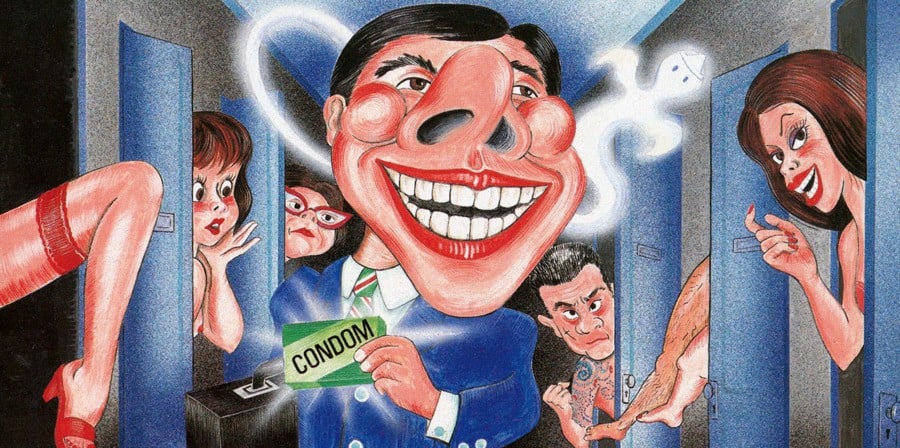
Don't worry – you're not suffering from déjà vu. If you feel like you've read this before, it's because we're republishing some of our favourite features from the past year as part of our Best of 2024 celebrations. If this is new to you, then enjoy reading it for the first time! This piece was originally published on February 8th, 2024.
At Time Extension, we like to promote the noble work of preservation groups such as the Japanese Game Preservation Society.
As such, we are sharing this fascinating piece of research featured in their latest English language newsletter. As an NPO, their ability to acquire, archive, preserve, research, and document the history of Japanese games is thanks to the support of the community. Have a look at the newsletter and peruse some of their documentary videos, all of which are free; while they ask for reader subscriptions, they do not gatekeep their work.
The topic for this feature, erotic games, was selected specifically because most Western researchers and journalists would shy away from it. But this is the wrong attitude - major developers such as Dragon Quest creator Yuji Horii, and others, started out making "eroge", and it provided an open and experimental creative environment that would foster ideas for later games. Like it or not, many of the popular games you play today have their ancestral DNA in eroge.
Please enjoy this collaborative feature kindly shared by the GPS.
Amorous Adventures And Strawberry RPGs: Two Titillating Threads In The Scandalous Origins Of Eroge
Note: This article covers two important threads in the development of erotic games from Enix and Koei. Due to the scope of the content, it does not cover other important developments, such as lolita and stripping games, and extends only through 1985. Further research is welcomed.
What is eroge? In the loosest sense of the term, eroge are games with erotic content drawn primarily in an anime or manga style. In a stricter sense, the term is used to describe games where the player’s primary goal is to view erotic content over a gameplay experience. This differentiates eroge from bishoujo games, which depict bishoujo, or pretty young female characters, and also contain nudity. However, the primary motivation of a bishoujo game is to engage in gameplay and story, not to view erotic content, although such content undoubtedly serves as a selling point.
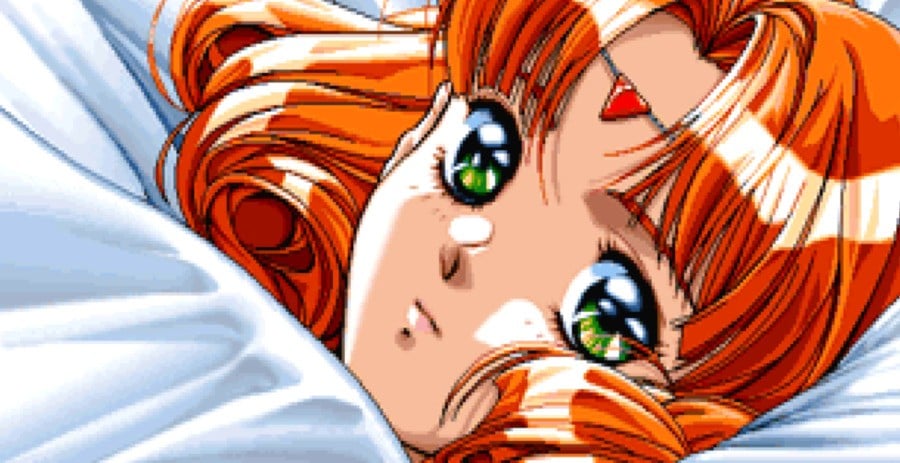
Regarding the content of eroge, following Japanese laws, genitals are either obscured or censored by pixelation, and all characters engaging in sexual acts must be 18 or older or not have their age stated. Significantly, depictions of sexual violence, sex crimes, and other acts of violence are not uncommon. Additionally, the audience for eroge is not exclusively cis-male, as they may target cis-women and LGBTQ+ players. Although initially, eroge were largely unregulated, today, they are monitored by the EOCS (Ethics Organization of Computer Software, or Sofurin). Occasionally, their contents are illegal outside of Japan.
It is hard to understate the staggering size of the Japanese eroge industry. Hundreds of titles are produced each year, counting millions in sales, and at least 20,000 people are thought to be employed full-time making them. In addition to the obvious desire for erotic content, low production costs - owing to passable artwork, some story and music, and minimal programming - and high price means developers can produce games cheaply and sell only a small amount to break even, thus providing a low barrier to entry and high sustainability. They are also a uniquely Japanese phenomenon.
Why Are Erotic Games Common In Japan, But Not The West?
Eroge have been historically prevalent in the Japanese computer game industry owing to two main factors. First, Japan has a culture more accepting of erotic media (so long as it abides by censorship laws) and possesses a long history of erotic content in artistic and popular culture. This owes largely to the importance of fertility in Shintoism, which even depicts the creation of the islands of Japan as part of a sexual act. Historically, erotic content first appears in the Heian period (794-1185) and is associated with the courtier class and their artistic and cultural refinement: notably, the first Japanese novel, Genji Monogatari (Murasaki Shikibu, early 11th Century), portrayed the sexual escapades of Hikaru Genji, the fictional son of an emperor.

The Heian period also saw the origins of shunga, erotic artworks depicting sexual acts. Literally read “spring pictures”, shunga is a shortening of shunkyu-higi-ga (“spring palace secret paintings”), which were a set of Chinese scrolls depicting the twelve sexual acts performed by the crown prince and associated with each of the twelve months. Although initially shunga were primarily for the nobility and monasterial classes, they remained an important theme of Japanese art and were even considered good luck charms by samurai and shopkeepers. Shunga became widespread in the Edo period (1603-1867) owing to the mass production of woodblock printing and the sophisticated ukiyo-e (“floating world”) style that is highly prized today. In fact, many famous ukiyo-e artists such as Hokusai created shunga during their careers. A series of imperial edicts did little to stymie the production and distribution of shunga, although Victorian influences during the Meiji era caused erotic content to be viewed as taboo and shameful. Although shunga were finally replaced by erotic photography, manga and anime are considered to have extended this tradition to the modern era.
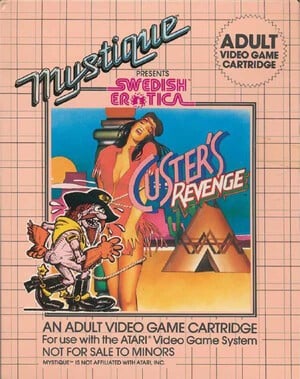
Thus, eroge may be seen as a natural extension of Japan's mass-produced erotic culture and were readily available for purchase at computer stores or via mail order. However, they were also heavily advertised in enthusiast magazines accessible to youths - and prior to the 1991 ‘Saori Incident’, could also be freely purchased by minors from computer stores.
In contrast, when early American erotic titles like Softporn Adventure (On-Line Systems, Sept. 1981, Apple II), Custer’s Revenge (American Multiple Industries, Nova. 1982, Atari VCS), and MacPlaymate (PEGASUS Productions, Jan. 1987, Macintosh) released, they met with strong negative press and forceful letters to editors whose publications included advertisements or reviews (although such press tended to boost sales). While some titles were advertised in trade publications like Billboard and enthusiast magazines like Softalk and InfoWorld, many mainstream magazines refused to advertise them or pulled advertising in response to subscriber feedback. Unless offered by major publishers, most erotic games had extremely limited distribution. The only major ‘catalogue’ for such software was The Dirty Book, a quarterly publication of erotic games first offered in Fall 1981 by Bourbon Street Press (which prudent publications were more willing to advertise).
The second major factor is computer platforms are open systems that do not require a development license and are relatively cheap to publish on. In contrast, home game consoles require developers purchase a license for a development kit and actively regulate content; additionally, cartridges were far more expensive than cassette tapes or floppy disks. So while eroge from unlicensed developers occasionally appeared on home game platforms as early as the Famicom Disk System, it was much easier to develop for computers. The creators of these early games were hobbyists, and would just as often produce clones or inspirations of popular coin-op games as they would unique experiences, including erotic ones.
Where Did Eroge Originate?
The earliest known erotic Japanese game is Yakyuken, which was discovered and masterfully described by Joey Wawzonek. The game was first advertised in the July 1979 issue of Mycom magazine as one of thirty titles for the MZ-80K available by mail order from Hudson Soft. Yakyuken (lit. “baseball-fist”) is a rock-paper-scissors style game originally conceived as a team-building exercise for an out-of-luck baseball team but later popularized as a stripping game by a comedy duo in 1969. The content is relatively tame, with blocky black-and-white graphics depicting a young woman in various states of undress. The MZ-80’s limited graphical capabilities, which consisted of an 80 x 50 column display and a blocky character set, produce results far less provocative than the curvilinear pinup art that had appeared on American computer terminals since the 1950s or on ASCII teletype printouts.

While some critics hesitate to label Yakyuken as an eroge, it serves to illustrate two key points. First, erotic content was present in Japanese commercial computer games since their inception, owing to the hobbyist nature of the market where developers made whatever interested them, the prevalence of erotic content in other media, and the fact publishers felt no need to curate their content since it wasn’t being scrutinized. Second, while Yakyuken was popular enough to see a full-colour version on the MZ-700, it was not successful enough to lead to more erotic titles at Hudson and does not appear to have influenced any other developers. However, it is notable that many early erotic games do contain yakyuken stripping as a mechanic or minigame.
It would not be until the next generation of Japanese computers, such as the NEC PC-8801 (Nov. 1981), PC-9801 (Oct. 1982), and Sharp X1 (Nov. 1982) that it was possible to display detailed images. These computers sported high graphical resolution due to the need to display kanji. 640 x 200 pixel screens with 8 colours were standard, with high-end models such as the PC-9801 even reaching 640 x 400 pixels and 16 colours (compared with 320 x 200 pixels and 16 colours on the Commodore 64 (Jan. 1982)). However, the limited colour palette, RAM, and the storage capacity of cassette tapes and 5.25” floppy disks meant it was not possible to display or store photographic images. Instead, artists relied on anime style drawings, often generated by drawing lines on the screen and filling in shapes with solid colour. Such images used less storage since they consisted of a set of commands to draw images, but they were also time-consuming to draw, which privileged slower-paced, text-heavy games with large static images - a natural format for graphical adventure games.
Enix’s Adventures In Eroticism
The first major thread in the origins of modern eroge was the adventure game. The adventure game genre is rooted in text adventures, beginning with the seminal Colossal Cave Adventure (Will Crowther & Don Woods, PDP-10, 1976). These games were originally played on teletypes or computer terminals and featured gameplay elements of exploration and puzzle solving revolving around item collection. Story consisted primarily of provocative descriptions of rooms and varying levels of character interaction.
Roberta and Ken Williams were the first to add a graphical dimension with their highly influential Mystery House (On-Line Systems, 1980). Their formula that proved extremely successful, selling over 80,000 units worldwide and influencing game designers around the world. The genre found its way to Japan first as Micro Cabin’s unlicensed Mystery House (MZ-80B, June 1982), which borrowed the title but contained a unique scenario and set of puzzles, before receiving an official release by On-Line’s Japanese distributor, Starcraft (PC-8801 / 9801, April 1983). As Japanese players and designers became enamoured with this new genre that was perfectly suited for their higher-resolution computers, there was a distinct shift from the Western style of gameplay emphasizing collecting objects to solve puzzles to a more Japanese style focusing on story and characters over puzzles and item collecting.
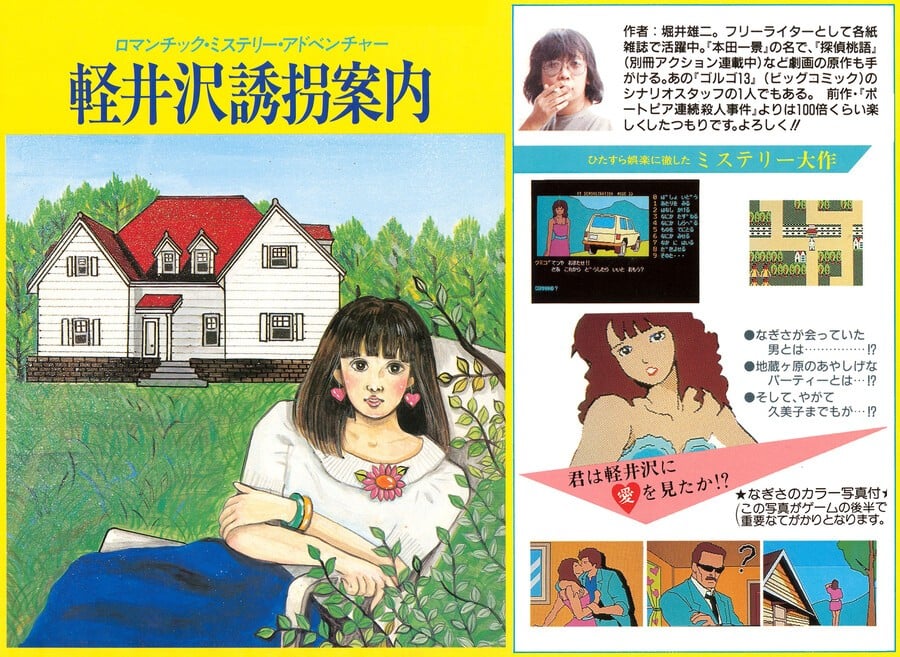
The most influential of these early titles was Portopia Renzoku Satsujin Jiken (The Portopia Serial Murder Case, Enix, June 1983, PC-6001) by Yuji Horii, where players take the role of a detective investigating the apparent suicide of the president of a loan shark company. Horii’s experience writing manga contributed to the game’s crisp dialogue, while a simplified command system, modern setting, companion character, unreliable narrator, and twist ending all helped the game stand out.
The graphical adventure game format revolutionized by Horii would quickly find its crossover with eroge. Horii’s next project was a new mystery game, Karuizawa Yukai Annai (The Karuizawa Abduction Note, Enix, May 1985, PC-8801) where players must rescue a young girl who has been kidnapped. Significantly, the game includes panty shots and sex scenes as well as the kernel of Dragon Quest through a map and RPG-style combat system in the game’s final chapter, which was inspired by Ultima III: Exodus (Origin Systems, Aug. 23, 1983, Apple II). An interesting sidenote: Karuizawa’s protracted development was interrupted by Horii’s creation of another adventure game, Hokkaidō Rensa Satsujin: Ohōtsuku Ni Kiyu (The Hokkaido Serial Killer Vanishes in Okhotsk, Dec. 21, 1984, PC-6001/8001). Horii would later collaborate with Koichi Nakamura to convert Portopia to the Famicom, which required the creation of an original menu-based interface that set the template for adventure games and RPGs. The duo then created Dragon Quest.
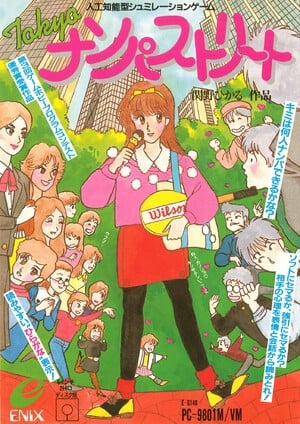
At the same time, Horii was working alongside his old friend from Waseda University, Hikaru Sekino, a manga artist who was developing TOKYO Nampa Street (Enix, FM-7, April 1985). As a nampa - a seducer who picks up dates in public venues - players go to different locations around the city and call out to women who pass by to get their attention and have a conversation in a coffee shop or park. Players select different topics, and the woman’s reactions change as the conversation develops using a rudimentary AI system - an attempt to simulate women’s psychology drawn from psychology literature and Sekino’s own experience. If the player successfully seduces the woman, he can invite her to a hotel, where a sex scene ensues. Otherwise, she leaves, and the player has to try again.
However, if the player attempts to rape her, he is arrested. The player has a limited budget for his hotel room, and the game ends once his money runs out or if he accidentally picks up an undercover officer or a transvestite. TOKYO Nampa Street was revolutionary for its time and served as the originator of the love simulator (or ren’ai, romance game), which later developed into the dating sim. Horii shared ideas as Karuizawa was in development, and he is credited with “Cooperation for Development” in the title screen. The collaboration was successful, as Sekino received an Excellent Program Award in Enix’s 3rd Game Hobby Program Contest.
Koei & Eroge
While Enix was breaking new ground in erotic game content, another developer and publisher, Koei, was making its own contributions to game history. Founded in 1978 by Yoichi and Keiko Erikawa, the company had already made history with strategy wargames, business simulations, and proto-RPGs. In April 1982, they produced another revolutionary product, Night Life (PC-8801). Although commonly described as a game, it contains no ludic content, and is best described as utility software meant to assist couples with their sex life and help conceive children.
The Erikawas had read articles on the difficulty couples were having conceiving children and how the odds could be increased using the Ogino Method to chart the woman’s menstrual cycle to determine when she was most fertile (as well as least fertile ‘safe days’) - a type of program that is still popular on modern smartphones. To add more “playful” content, the program included diagrams of sex positions, a questionnaire to help spice up the couple’s sex life, and advice on how long to spend in each position. The closest Night Life comes to being called a “game” is that it can be considered to have “gamified” the goal of conceiving a child. It is clear the Erikawas collaborated on this title, as the initial software release is signed “K. Erikawa.”
Night Life was not the first software of its kind, either. That same year, Imagesoft (later Pax Softnica) released a similar program, Love Life, for the Apple II, and in May 1980, American developer Syntonic Software produced the highly successful text-only Interlude, also for the Apple II, that served as a catalogue of inspirations for spicing up a couple’s sex life.
Koei followed up Night Life with the first erotic RPG, Danchizuma no Yuwaku (Seduction of Condominium Wives, April 1983, PC-8801). The title literally translates as “Seduction of Apartment Wives” – however, the translation “Condominium Wives” benefits from a pun on the word “condom”. Players take the role of a condom salesman who must sell his goods to women who are home alone in an apartment complex. Through a stats and commands system similar to the strategy war games and RPGs Koei had created previously, players fight yakuza and ghosts while seducing the women in the building and getting them to have sex. During sex scenes, the player presses keys to try to make the woman climax first. The game ends when the player’s physical strength or intelligence becomes 0, they run out of time, or successfully sell all their products. Danchizuma was billed as an “adult porn role-playing game”, and Koei established the Strawberry Porno label to market it. The game proved extremely successful.
This was followed by Orandazuma wa Denki Unagi no Yume o Miru ka? (Do Dutch Wives Dream of Electric Eels?, Dec. 1984, PC-8801). Inspired by Philip K. Dick’s Do Androids Dream of Electric Sheep? (1968), players take on the role of a private investigator who has to track down a sex doll (called Dutch wives in Japan) that has become sentient and is murdering its lovers. The player tracks down the rogue doll by seducing all the women in Tokyo’s red-light district. The game expands on Danchizuma’s mechanics by adding the twist that players must first seduce the women by taking them out on dates and finding out their likes and dislikes before performing the correct actions in bed to find out if they are a robot.
Significantly, neither game has fully explicit sex scenes, as the genitals are covered by cleverly placed censor bars that read "paso-rin cut", a parody of the “vide[o]-rin" censor bars placed in softcore erotic “pink films” by the Nihon Video Rinri Association.
Surprisingly, Danchizuma and Orandazuma are inspired by the popular Nikkatsu Roman Porno films. These theatrical pink films were created in response to the studio’s loss of revenue owing to competition from television and were produced rapidly at an average of three per month. Directors were given a surprising amount of artistic freedom, provided they included a minimum of four nude scenes per hour and adhered to Japan’s censorship laws governing full-frontal nudity. Romano Porno proved incredibly successful, turning Nikkatsu around and capturing the market for pink films. Rather than sleazy sexploitation films, many Romano Porno were often critical successes and regularly appeared on annual top ten lists of Japanese films. Several themed series were created, including the longest-running 21-film Danchizuma series that ran from 1971-1979, beginning with the studio’s initial release, Danchizuma hirusagari no joji (Apartment Wife: Affair in the Afternoon, Nov 21, 1971). With such a significant impact on Japanese popular culture, Koei’s Danchizuma reference would have been obvious.
Following Orandazuma, Koei left the erotic game market because it presented the company in a negative light, and their tactical strategy games were proving far more profitable. However, the success of the Strawberry Porno series led to an explosion of knock-offs, some produced by such famous companies such as Enix, Square, and Nihon Falcom.
Why Discuss Eroge?
Given the distinct aversion Western - and particularly American - culture has for erotic media, it may be difficult to argue for a critical analysis of eroge. However, it is inarguable that eroge have played a significant role in the history of Japanese videogames and had a profound influence on mainstream game design. Perhaps most obviously, dating sims and relationship mechanics popular in series such as Tokimeki Memorial and Persona originated as ren’ai games where the goal was to seduce women and be rewarded with erotic content. Many famous publishers included eroge as part of their early catalogues, although they understandably try to distance themselves from this history today.
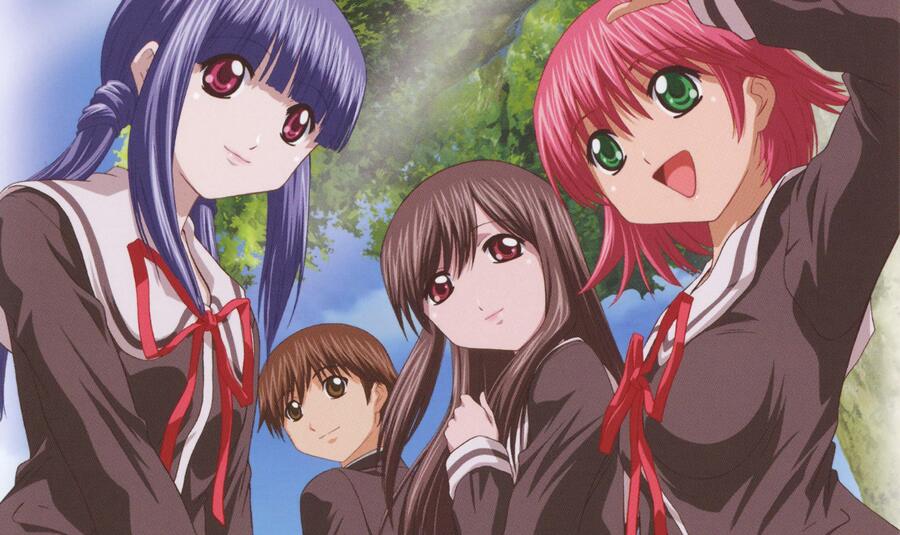
Finally, many early developers of eroge went on to develop significant titles later on; it can be said the freedom of expression in home computers and in eroge as a genre allowed them to freely experiment with game mechanics, art, and storytelling that might not have been acceptable in a more conservative market.
It is therefore important that the history and impact of eroge be better understood, even though some of the content may be disturbing or objectionable to some audiences. This is one of the reasons the Japanese Game Preservation Society preserves and studies these games.
This feature was originally published in the Japanese Game Preservation Society newsletter and has been reproduced here with kind permission.
